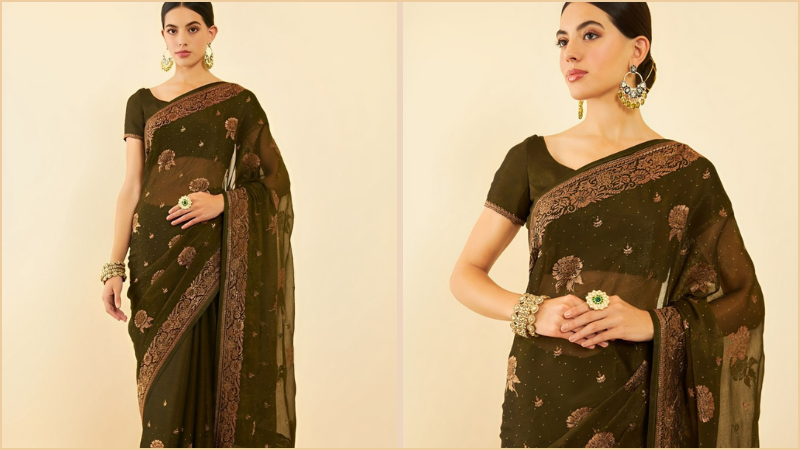Sarees, the traditional Indian garment, has gained popularity in Pakistan due to cultural exchange and fashion influence. Pakistani women are fascinated by the rich colours, intricate designs, and elegant draping styles of sarees, increasing their demand. Bollywood movies and celebrities significantly impact Pakistan's fashion trends, and many Pakistani designers have started incorporating sarees into their collections. Social media and online shopping have also made Indian sarees more accessible to Pakistani women, further fueling the trend.
Sarees are becoming popular in Pakistan as they represent uniqueness and a fashion statement. They are now worn not just on formal occasions but also to work, weddings, and parties due to their versatility in fabrics, designs, and draping styles. Pakistani women want to incorporate elegance and grace into their wardrobes, and the saree is seen as a symbol of these qualities.
In this article, we will discuss the most suitable fabrics for sarees, their unique characteristics, styling options, and tips for caring for them. So, let's get started and explore the world of saree fabrics!
The fabric used in a saree significantly impacts its overall appeal. Whether you prefer cotton's smoothness or silk's lustrous beauty, the fabric you choose can make all the difference. This post will discuss the best fabrics for sarees, their unique features, styling options, and care instructions. We'll start with the most critical information and keep sentences short and to the point. We'll use everyday language and avoid technical terms. So, let's get started and explore the world of saree fabrics!
The Best Fabrics for Sarees: From Silk to Cotton:
Silk and cotton are two well-known fabrics for sarees. Let's examine each of these fabrics and their distinct features.
Silk Sarees:
Silk sarees are famous for their shine, texture, and designs. They are commonly worn at weddings, formal events, and religious ceremonies.

Kanjeevaram, Banarasi, Tussar, and more are types of silk sarees. Pure mulberry silk is used to create Kanjeevaram sarees, which are famous for their bright colours and long-lasting properties. Fine silk is used to craft intricate zari work in Banarasi sarees. On the other hand, Tussar sarees have a natural, earthy texture and are made from wild silk.
The production of silk sarees is a complex and lengthy process that involves extracting from silkworms, converting them into threads, and weaving them into fabric.
Silk sarees should be dry-cleaned to maintain their shine and prevent harm.
Silk sarees are durable, have a lustrous sheen, and intricate designs. Special care is needed for them, and they can be pretty costly.
Cotton Sarees:
Cotton sarees are ideal for everyday use as they are lightweight and breathable. They are available in different varieties, such as Chikankari and Kota Doria. The Chikankari sarees are famous for their intricate embroidery, whereas the Kota Doria sarees are known for their delicate texture and checkered patterns.

Cotton sarees are produced by spinning cotton fibres into threads and weaving them into the fabric.
When it comes to maintaining cotton sarees, it is crucial to wash them in cold water and refrain from using harsh detergents. Hanging them to dry in a shaded area is recommended to prevent discolouration.
Cotton sarees are lightweight and breathable, which makes them ideal for hot and humid climates. While they can be a comfortable option, clothes made from specific materials like linen or cotton can wrinkle easily and may not last as long as other fabrics.
Chiffon Sarees:
Chiffon sarees are sheer and lightweight. They're ideal for formal events and come in various types, such as Crepe and Georgette chiffon.

Chiffon sarees are made of synthetic fibres and come in two types - Crepe and Georgette. Crepe chiffon has a textured appearance, while Georgette chiffon has a slightly heavier drape.
Hand wash chiffon sarees in cold water, avoid wringing them and dry them in a shaded area.
Chiffon sarees are lightweight and sheer, perfect for formal events. However, they are delicate and can snag easily.
Crepe Sarees:
Sarees are often made of crepe fabric, which has a crinkled or pebbled texture. Silk, wool, or synthetic fibres are used to make it, and it has a lightweight, flowy drape. Crepe sarees are known for their wrinkled appearance, which adds a unique dimension to the saree.

They are available in various colours, some of which may have intricate threadwork or embroidery. Working women often choose crepe sarees because they are suitable for formal and casual occasions.
Choosing the Right Saree Material:
Suitable saree material depends on various factors, including occasion, body type, and climate.
Silk, chiffon, and net sarees are sumptuous for formal events, while cotton sarees are perfect for everyday wear.
When choosing a saree material, it's essential to consider your body type. Lightweight materials such as chiffon and georgette may be a great choice if you have a slim frame. On the other hand, if you have a fuller figure, heavier materials like silk and cotton may be more suitable.
Consider the climate when choosing saree materials. Light fabrics like chiffon and georgette are perfect for hot weather, while silk and cotton are better for cooler climates. When matching sarees with blouses, choose a simple, solid-coloured blouse for a heavily embroidered silk saree and a bold, printed blouse for a plain cotton saree.
When buying sarees, it's essential to ensure quality by purchasing from reputable sellers, checking the fabric, and stitching for fault.
Conclusion:
Selecting the suitable saree fabric is essential for creating a stunning outfit. Sarees have importance beyond being just a garment. They hold great cultural and traditional significance. A saree's overall appearance and texture can be significantly affected by the type of fabric used. Each fabric has unique properties, from silk to cotton, making sarees suitable for all occasions. So, the next time you wear a saree, take a moment to appreciate the fabric and its role in making you look and feel beautiful. Depending on the occasion, body type, and climate, you can choose silk, cotton, chiffon, georgette, or net sarees. Properly retaining their beauty over a long period is possible with appropriate care and maintenance. Pandi is always here to serve you with the fabrics you need for sarees.













